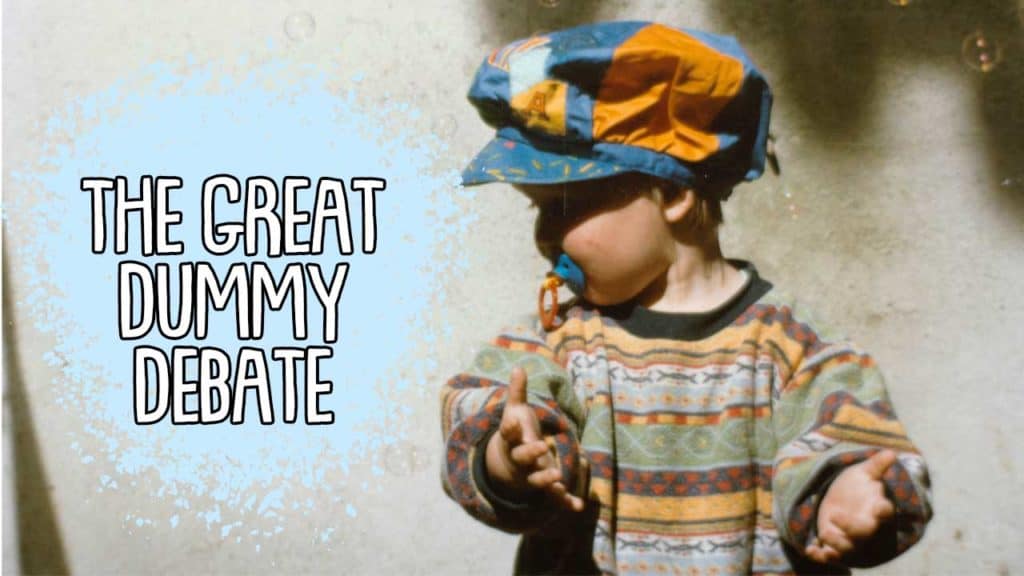Dummy, pacifier, binky, whatever you want to call it, it’s a savior for many parents. It’s a savior for fussiness, helping with settling your baby to sleep and overall comfort for your child. It is also without a doubt the cause of great debate and controversy in the parenting community.
Should you use one? When should you ditch the dummy? Are they safe? Are they needed? Do they help or hinder good sleep?
There are so many opinions on the necessity of the pacifier and whether or not you should use one. Some babies love their dummy from the moment they first lay their lips upon one, while others never get the hang of it, and are not impressed when it’s introduced. For some parents, it’s a vital tool in their baby bag and is never without one; for others it’s unnecessary. But what about you?
Dummies are one of those things that parents can get judgy about, “I won’t have my three-year-old running around with a dummy in their mouth.” I’m here to give you all the facts without the judgment so you can make the best decision of you and your family.
Table of Contents
Pacifiers and Newborns
Between birth and 4 Months is the best time to use a pacifier. They have been proven to be beneficial for newborn babies in several different ways.
Pacifiers trigger the calming reflex.
Dr. Harvey Karp introduced the world to the 5 S’s – swaddling, shushing, swinging, side settling and sucking. Sucking is an excellent soother for babies and a unique way to help calm your newborn ready for sleep.
Sucking reminds babies of being in the womb.
The sucking reflex develops between 32 and 36 weeks gestation, and babies often suck their thumb in the belly. While in the womb newborns had much smaller space to move around it and could easier find their fingers to suck. Out in work, they have more space and don’t have the coordination yet to bring their hand to their mouth. The pacifier is the perfect device to meet your baby’s sucking comfort needs.
Babies need to be able to suck to feed, and it’s a survival mechanism.
There is nutritive sucking and non-nutritive sucking. Nutritive sucking is when the baby is feeding on the breast or bottle, and non-nutritive sucking is when babies are sucking on a dummy for comfort.
Sucking a pacifier lowers the risk of SIDS.
Impressive, researchers are not sure why, but they know sucking reduces the risk of SIDS even if the dummy falls once the baby is asleep.
Sucking has been shown to decrease blood pressure and the heart rate helping to relax, calm and de-stress the baby.
Using a pacifier also stimulated the release of natural pain-relief chemicals in the brain.
There are so many incredible benefits to using a pacifier when your baby is under the age of 4 months and not any drawbacks. At this stage, I wouldn’t worry about your baby forming an attachment to their pacifier. Sleep associations start to develop around 6 to 8 weeks of Age, but they won’t become a deeply rooted association for some months yet. Using a binky also stops mum from becoming the pacifier. It is when the baby is not interested in feeding, but wants the comfort of sucking. It is a great time to start using a dummy.
How to Introduce a Dummy
Introduce the dummy once you establish breast or bottle feeding. Offer your baby the pacifier when they are swaddled and ready for their nap. Or if they resist taking the dummy try to offer it just after a feed when your baby is cute and relaxed. Don’t force it on your baby, but keep trying to re-introduce it maybe once a day until they are happy to take it.
You can also encourage your baby to take the pacifier by inserting the dummy once you have finished feeding, then when your baby begins to suck pull on the dummy slightly, so it moves away from their mouth. It encourages your baby to suck harder. You can repeat this little game for 5 to 10 mins over a few days to help your baby get used to the dummy.
Don’t ever dip the dummy in something sweet like honey to try and encourage your baby to suck on it. Honey can be dangerous for babies under the age of 12 months as it can contain Clostridium Botulinum which can release a toxin that is poisonous to babies.
Also, babies don’t need any sugar or sweets in their diet; they don’t need anything except for breastmilk or formula as their digestive system is not mature enough to process different foods, even a tiny taste.
Sometimes, however, no matter what you do your baby might not like the dummy and that is okay too. While it is a great calming tool, there are other ways you can help your newborn settle for sleep.
Dummy Do’s and Don’ts
| Do’s | Don’ts |
| Wait until breast/bottle feeding is established and going well | Dip the pacifier in anything sweet |
| Give your newborn a pacifier | Tie or attached the binky to your child’s clothing |
| Keep clean by washing with hot soapy water and sterilizing | Give dummies that are cracked or broken |
| Use for comfort and help settling to sleep | Use a bottle nipple in place of a dummy |
| Replace dummies after a few months | Use instead of feeding |
| Try different brands until you find one your baby likes | |
When to Ditch the Dummy
It is a personal decision based on your own parenting beliefs and the needs of your child. To begin with, it’s a choice you make, and then as your baby grows into a toddler, it will be a choice that you make together. Whatever your choice, it’s up to you and your family.
Before 6 Months of Age
Both my boys had dummies when they were newborns, and I never thought consciously about when I would get rid of them. As long as they were working, I’d be using them. However, when the boys were around five months old, the pacifiers started to become a real nightmare for me.
By this point, the boys were sleeping through the night with a dream feed, but…. I was still getting up multiples times a night. I was getting up just to put the dummy back in. Every time it fell out they would start to cry, and I’d be up and popping it back in, and they’d fall straight back to sleep.
I think If I had just one baby, I may have persevered until I could teach them to find and replace their pacifier, but with two I often felt like I was up every hour with either one of them to put their dummy back in.
I decided to ditch the dummy for good.
Getting rid of the dummy between 4 to 6 months of Age is going to be the easier time and should only take a few days. Although your baby may have gotten used to falling asleep with the dummy or enjoy the comfort of sucking they don’t need it anymore.
The benefits of using are all related to the newborn stage, and because it is still early they are not too attached, and the sleep association with the dummy is not too deeply rooted. With a few days of gentle sleep training, you can ease your baby away from it.
How to Get Rid of the Dummy Early
Just Go Cold Turkey
It is what I did, and it worked well and quickly. After a few weeks of multiple wake ups with my twins, I collected all the dummies them and threw them in the bin. No more dummies. I chose a sleep training method I was comfortable with, and it took three night and days for my boys to learn to settle without it.
The first day without the dummy will be the hardest, but at this age, babies adapt quickly, and with consistency, you’ll be a dummy-less family in a few short days. It is the easiest and quickest way with a baby under six months of age. The earlier you stop using the dummy, the easier it will be for your baby to give it up.
Phases Out the Dummy
If you prefer you can use a slower approach. It can be challenging to stay consistent, and it’s easy to pull the dummy out. But it can work with a committed approach. For a few weeks, you can begin to offer it less and less.
Stop giving during the day. Then, stop giving it for naps and lastly stop giving for bedtime and night wake ups. You will probably need to use another method of settling with your baby while they get used to not having the dummy anymore.
Between 6 to 12 Months of Age
If your baby is still using the dummy at this age, it has probably started to become a strong sleep association, and that is okay. As the dummy has started to become a strong sleep association, it becomes difficult to remove and unnecessary. At this age, it is easier to start focusing on helping your baby to find and replace their dummy to save you from the dreaded dummy run several times during the night.
Find and Replace
To teach your baby to find and replace their dummy start by placing the dummy in your baby’s hand and then guiding their hand holding the dummy up to their mouth. Continue this for a few days. Next, put it in your baby’s hand and let them bring it to their mouth by themselves and do this for a few days. Next, place it on the mattress next to your baby and allow them to grab by themselves and put it happily in their mouth. It will be a happy day for mum and bub. You can start practicing this skill at the six months, but they may not get the idea until closer to 7 or 8 months.
Tips for Find and Replace and Bedtime
- Scatter the cot with dummies to make it easier for your baby to find. Leave one or two with your baby when they go to sleep and add more in their cot before you go to bed. This way they won’t be distracted and want to play with all the dummies in their furniture and potentially lose them, but they will also be handy when they needed it in the middle of the night.
- Introduce a Sleepytot. It is a beautiful sleep approved lovey which your baby can snuggle and cuddle all night long. The added benefit is that you can attach four pacifiers to the Sleepytot making it easier for your baby to find their dummy.
- Use glow in the dark dummies for night time sleep to make it easier for your baby to find it in the dark
Pacifier Problems
At some point, your child’s beloved binky will have to go. You know they don’t need it anymore, and maybe it is becoming more of a problem than a help at this stage.
1. A toddler can start to become very challenging wanting their way in their own time. It is entirely normal and healthy. They are looking for and practicing their first steps of independence from their parents.
However, the dummy can become the cause of the enormous meltdown, if the right one is lost, if they want to have the dummy all the time if they cannot sleep without it, and the list of potential tantrums rolls on.
2. Prolonged Pacifier use (usually meaning longer than three years of Age) linked to higher rates of middle ear infections in toddlers.
3. Dummies have been shown to affect children’s’ dental development if used for too long. Prolonged use can cause the crossbite, this is when the upper teeth fall behind the lower teeth instead of in front of them, or an overbite when the front teeth are pushed out far in front of the lower teeth.
4. Pacifiers and speech development. Again we are looking at prolonged use here over 2 to 3 years of Age. This extended use of the dummy has been shown to change the shape of the mouth resulting in difficulties for the child to articulate their sounds properly.
With these potential issues in mind, it is generally recommended you aim to have removed the dummy by 24 months of age. However, work with what fits your child best and their development.
Bye Bye Binky in the Toddler Years
So now your little one is firmly attached to their binky and going cold turkey is going to be no fun for anyone and potentially explosive. Here are some handy tips to help you and your child say “Bye, Bye to their binky.”
- Slowly for weeks or months let all the dummies become lost and don’t buy anymore. It is a nice gradual way to get rid of the dummies without your child necessarily realizing. Then you tell them, the dummies are all gone there are none left, but you are such a big boy now you don’t need your dummy anymore.
- A variation on losing the dummies is to slowly snip or poke holes in the dummies when you find them. This way they are no longer pleasant to suck on. You can tell your child “oh no, it’s broken lets put in the bin.”
- The cutest way is to round up the dummies and put them in a unique bag to leave out the for dummy fairy. You can tell your toddler that the dummy fairy will give them dummies to all the baby who needs now.
- Bribery – There are a time and place for bribes. If they give it up you’ll have a special outing; they will get a puppy, a toy they have been wanting, the list of potential rewards is endless. It can work well in this instance.
- Use your child’s favorite characters. Tell them Peppa Pig needs the dummy for her baby cousin and leave a little thank you card and gift from Pepper. Perhaps Batman needs it to save the world, again leave your child a special gift from Batman.
- Gather up all the pacifiers, put them in a post bag and post to the babies who need the dummies now.
Use your imagination on the best way to help your child let go of their beloved binky.
We know it’s possible as I have yet to see a 30-year-old walking around sucking their dummy, but it might just be a few days or weeks of frustration. Change is okay and healthy but can be difficult and frustrating.
Kendall and Mac – How This Mommy and Her Daughter Got Rid of the Dummy
McCarthy’s Dummy
I introduced the dummy to McCarthy while trying to wean her from her 1 am feed. It then organically became a sleeping tool, and she would only use when she was sleeping, and maybe enjoy it for a little longer while she was waking up.
Towards the end of her second year into the life, she started biting holes in them, which of course took their enjoyability away. I explained to her that her biting was making the holes, which were destroying the dummy, and that if she kept doing it, we were going to run out.
But she continued doing it, and every piece of it went in the bin, (there were about 4 or 5) we discussed what was coming, the end of having her dummy during sleep. But she continued to chew holes until we went to the last one.
Once the hole was made she told me there were “no more” and threw it in the bin herself. I encouraged her peace with saying goodbye to it, gave her an encouraging cuddle, and that was it. That night I didn’t mention it, and neither did she, the dummy/sucking to soothe to sleep was gone. Hers wasn’t brought up again until she asked if she had one when there was a baby with one when she was about four.





